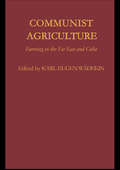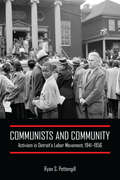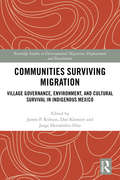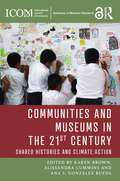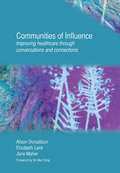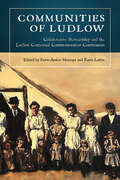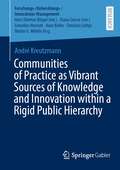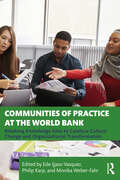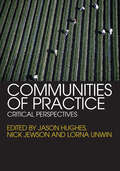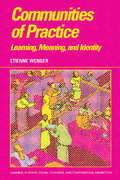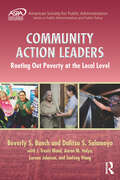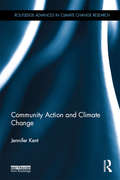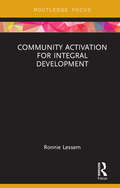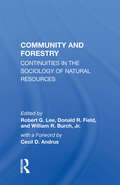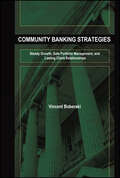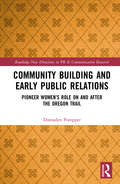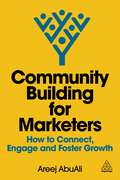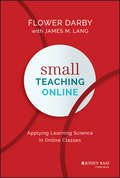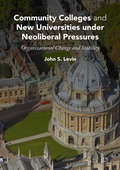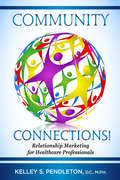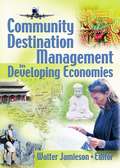- Table View
- List View
Communispace
by Anat KeinanCommunispace is the market leader in creating and managing private, brand-focused online communities for major corporate clients. These communities have provided its clients with insights into how consumers view their brands, with quick feedback on potential marketing decisions, and with a sounding board for new product ideas. Now, a potential client has asked Communispace to build and manage an online community for the sole purpose of fostering Word-of-Mouth for a new brand it was launching. Should Communispace take on this assignment?
Communist Agriculture: Farming in the Far East and Cuba
by Karl-Eugen WädekinA fascinating comparative study of how the agricultural experience of the Soviet Bloc has shaped and sometimes hindered development in the rest of the communist world, this book examines the agrarian policies of China, Mongolia, Vietnam, and Cuba, and provides an account of agricultural development in socialist economies which focuses on both the historical and contemporary aspects of this development.
Communist Neo-Traditionalism: Work and Authority in Chinese Industry
by Andrew G. WalderAndrew Walder's neo-traditional image of communist society in China will be of interest not only to those concerned with China and other communist countries, but also to students of industrial relations and comparative social science.
Communists and Community: Activism in Detroit's Labor Movement, 1941-1956
by Ryan S. PettengillCommunists and Community seeks to reframe the traditional chronology of the Communist Party in the United States as a means to better understand the change that occurred in community activism in the mid-twentieth century. Ryan Pettengill argues that Popular Front activism continued to flourish throughout the war years and into the postwar period. In Detroit, where there was a critical mass of heavy industry, Communist Party activists mobilized support for civil rights and affordable housing, brought attention to police brutality, sought protection for the foreign-born, and led a movement for world peace. Communists and Community demonstrates that the Communist Party created a social space where activists became effective advocates for the socioeconomic betterment of a multiracial work force. Pettengill uses Detroit as a case study to examine how communist activists and their sympathizers maintained a community to enhance the quality of life for the city’s working class. He investigates the long-term effects of organized labor’s decision to force communists out of the unions and abandon community-based activism. Communists and Community recounts how leftists helped workers, people of color, and other under-represented groups became part of the mainstream citizenry in America.
Communities Surviving Migration: Village Governance, Environment and Cultural Survival in Indigenous Mexico (Routledge Studies in Environmental Migration, Displacement and Resettlement)
by James P. Robson Dan Klooster Jorge Hernández-DíazOut-migration might decrease the pressure of population on the environment, but what happens to the communities that manage the local environment when they are weakened by the absence of their members? In an era where community-based natural resource management has emerged as a key hope for sustainable development, this is a crucial question. Building on over a decade of empirical work conducted in Oaxaca, Mexico, Communities Surviving Migration identifies how out-migration can impact rural communities in strongholds of biocultural diversity. It reflects on the possibilities of community self-governance and survival in the likely future of limited additional migration and steady – but low – rural populations, and what different scenarios imply for environmental governance and biodiversity conservation. In this way, the book adds a critical cultural component to the understanding of migration-environment linkages, specifically with respect to environmental change in migrant-sending regions. Responding to the call for more detailed analyses and reporting on migration and environmental change, especially in contexts where rural communities, livelihoods and biodiversity are interconnected, this volume will be of interest to students and scholars of environmental migration, development studies, population geography, and Latin American studies.
Communities and Museums in the 21st Century: Shared Histories and Climate Action (ICOM Advances in Museum Research)
by Karen BrownCommunities and Museums in the 21st Century brings together innovative, multidisciplinary perspectives on contemporary museology and participatory museum practice that contribute to wider debates on museum communities, heritage, and sustainability. Set within the context of globalisation and decolonisation, this book draws upon bi-regional research that will enrich our understanding of the complex relationships between Europe, Latin America and the Caribbean through museum studies and practice. Chapters reflect upon the role of museums in defining community identities; the importance of young people’s participation and intergenerational work for sustainability; the role of museums in local development; and community-based museums and climate change. Contributors examine these issues through the lens of museum partnerships and practices, as well as testing the continued relevance of the notion of ‘integral museum’ and its relatives in the form of ecomuseums. With its focus on regional museums in Latin America and Caribbean, this book highlights how the case studies promote greater intercultural dialogue, global understanding and social cohesion. It also demonstrates how the methodology can be adapted to other communities who are facing the perils of climate change and unsustainable forms of development. Communities and Museums in the 21st Century proposes creative and sustainable strategies relevant to a globalised future. With its focus on global societal challenges, this book will appeal to museologists and museum practitioners, as well as those working in heritage studies, cultural studies, memory studies, art history, gender studies, and sustainable development.
Communities of Influence: Improving Healthcare Through Conversations and Connections
by Alison DonaldsonDedicated and hard-working staff at all levels of large healthcare organisations can be frustrated by a perceived inability to influence healthcare priorities. One way of enabling such practitioners to shape and improve services is to bring them together in 'communities of influence'. These are informal groups or networks of committed people who meet regularly to share experiences, develop a collective voice and influence policy and practice at local and national levels. Such 'bottom-up' approaches to change can complement the more conventional management mechanisms widely employed today. Communities of Influence tells the story of how a prominent UK non-profit organisation (Macmillan Cancer Support) has engaged both professionals and patients over the past two decades to improve cancer care. It will stimulate managers and practitioners alike to develop their capacity to work through networks, relationships and conversations in pursuing their objectives. This book will appeal to clinicians and managers responsible for service improvement, as well as public servants, researchers and educators interested in management and organisational change. At a time when the 'big society' is the policy idea of the day, this book illustrates what can be achieved when communities of practice become communities of influence. In so doing, the authors offer a timely counterpoint to believers in command and control and rampant competition by stressing the critical role of networks and relationships. The ideas they discuss are at once simple and complex and have the potential to be revolutionary when taken forward in the right hands. Professor Chris Ham, Chief Executive of The King's Fund This wonderful book describes how a creative, problem-solving organisation can be encouraged to start, grow and flourish. The result is a text that could act as a guide for 21st century healthcare, one of the key books for an era in which it will be recognised that new solutions are needed for the problems we face. From the foreword by Sir Muir Gray This book is a welcome antidote to the usual approaches to improving healthcare which take the form of endlessly changing organisational structures and relentless monitoring, often with dubious consequences. It presents an alternative, holding out the prospect of gradually accumulating changes in the actual work of those delivering healthcare in a complex environment. Professor Ralph Stacey, Complexity Research Group, University of Hertfordshire
Communities of Ludlow: Collaborative Stewardship and the Ludlow Centennial Commemoration Commission
by Fawn-Amber Montoya Karin LarkinFor more than one hundred years, people have come to the Ludlow Massacre Memorial site to remember the dead, to place themselves within a larger narrative of labor history, and to learn about what occurred there. Communities of Ludlow reveals the perseverance, memory, and work that has been done to enrich and share the narratives of the people of Ludlow and the experiences of those who commemorate it. The history of the Ludlow Massacre encompasses the stories of immigrant groups, women, the working-class, and people of color as much as the story of that tragedy, and the continued relevance of these issues creates a need for remembrance and discussion of how to make the events of the Ludlow Massacre available to contemporary society. The book outlines recent efforts to remember and commemorate this important historical event, documenting the unique collaborations in public scholarship and outreach among the diverse group of people involved in marking the 100-year anniversary of the Ludlow Massacre. The chapters relate the tales of the stewards of the Ludlow Massacre—the various communities that rallied together to keep this history alive and show its relevance, including lineal descendants, members of the United Mine Workers of America, historians, archaeologists, scholars, artists, interpreters, authors, playwrights, and politicians. The book also offers tips, strategies, and cautionary tales for practicing engaged public scholarship. The history of the Ludlow Massacre has been told as a tragedy of striking miners in the West that occurred during a turbulent time in US labor relations, but it is so much more than that. Communities of Ludlow explores the intersections of public scholarship, advocacy, and personal experience, weaving these perspectives together with models for practicing public scholarship to illustrate the power of creating spaces for sharing ideas and information in an environment that encourages creativity, open dialogue, public outreach, political action, and alternative narratives. Contributors: Robert Butero, Robin Henry, Michael Jacobson, Elizabeth Jameson, Linda Linville, Matthew Maher, Yolanda Romero
Communities of Practice as Vibrant Sources of Knowledge and Innovation within a Rigid Public Hierarchy (Forschungs-/Entwicklungs-/Innovations-Management)
by André KreutzmannThe concept of Communities of Practice is nowadays ‘common parlance’ in the private and public sector. However, research concerning the potential and benefits of CoPs embedded in public organizations lacks behind. Consequently, it still remains vague whether informal CoPs are able to unfold their widely recognized potential in terms of knowledge creation and dissemination within the context of the public sector. To shed light on this issue, the author employs the German Federal Armed Forces as a research setting since it is an outstanding example for a supremely hierarchical public organization showing a high degree of formalization in structure and processes. The research at hand particularly focuses the entanglement of the formal organization with the informal CoPs. More specifically, the author was inspired by the interest in exploring which role these informal entities play in regard to the development of knowledge and innovations, thereby, possibly fostering the organizational knowledge management as well as the adaptability of a supremely hierarchical public organization.About the authorAndré Kreutzmann prepared the dissertation at hand at the Institute of Technology and Innovation Management at the Helmut-Schmidt-University. As a member of a research project commissioned by the German Ministry of Defense, he investigated the potential of Communities of Practice in terms of knowledge management, innovation development, and organizational adaptation.
Communities of Practice at the World Bank: Breaking Knowledge Silos to Catalyze Culture Change and Organizational Transformation
by Ede Ijjasz-Vasquez Philip Karp Monika Weber-FahrIllustrated by the experience of the World Bank, this book explains how knowledge management, traditionally viewed as being about information systems and processes, can play a fundamental corporate role by creating a competitive edge for organizations, increasing team performance, and fostering effective, large-scale organizational change. Rich and powerful stories, told by economic development practitioners and knowledge management specialists throughout the World Bank, describe the strategies, instruments, tools, and processes at the core of one of the most important and radical reorganizations of the world’s premier international development institution. Going far beyond other knowledge management titles, this book: shows how knowledge management can be a source of competitive advantage and team performance, rather than a back-room support function focuses on the role of the "software" of knowledge management, most notably the use of communities, culture, and collaboration across internal silos to create value; and demonstrates the role that knowledge management can play in fostering innovation, and development of new business lines and strategies by global teams in diverse locations Written not only for knowledge management professionals, but also for C-suite executives and middle managers who will see the benefits of bringing knowledge management to the core of organizational performance and competitive advantage, the book provides practical examples that can be replicated in other large global knowledge, financing, and development institutions and that will be relevant for public, private, and non-profit organizations.
Communities of Practice: Critical Perspectives
by Jason Hughes, Nick Jewson and Lorna UnwinThis benchmark text provides an accessible yet critical introduction to the theory and application of communities of practice and their use in a diverse range of managerial and professional contexts, from education to human resource development. This book charts the development of the idea of communities of practice and explores the key relationship between learning and identity among: newcomers and ‘old timers’ male and female workers the low skilled and the high skilled professionals and managers adults and adolescents. Drawing on international empirical studies and adopting a multi-disciplinary approach, this book is useful reading for all students, researchers, practitioners and policy makers with an interest in work, employment, labour markets, learning, training or education.
Communities of practice: Learning, Meaning, And Identity (Learning In Doing Ser.)
by Etienne WengerLearning is becoming an urgent topic. Nations worry about the learning of their citizens, companies about the learning of their workers, schools about the learning of their students. But it is not always easy to think about how to foster learning in innovative ways. This book presents a framework for doing that, with a social theory of learning that is ground-breaking yet accessible, with profound implications not only for research, but also for all those who have to foster learning as part of their responsibilites at work, at home, at school.
Community Action Leaders: Rooting Out Poverty at the Local Level (ASPA Series in Public Administration and Public Policy)
by Beverly S. Bunch Dalitso S. SulamoyoNationwide, approximately 1,000 Community Action agencies advocate for the poor and provide diverse but critical services such as (but not limited to) emergency food and shelter, energy bill assistance, weatherization, education, job training, transportation, housing, and health services. In the face of dynamic environments and shifting poverty needs, Community Action agencies are constantly seeking innovative ways to effectively address poverty in their communities while building their internal capacity to ensure sustained impact and outcomes. This book focuses on the major leadership roles and responsibilities of the Community Action leaders, the types of challenges they face, and how they address those challenges, covering questions such as: How do Community Action leaders identify the needs of low-income people and use that knowledge to tailor programs to meet those needs? In what ways are low-income people involved in Community Action agencies (e.g. board or advisory council members, volunteers, employees, advocates)? What are the advantages and disadvantages associated with their participation? How do the leaders and their staff assess and demonstrate the effectiveness of their organizations and programs? What challenges do they encounter in assessing and communicating performance? What approaches are Community Action leaders using to diversify their revenues? What are the advantages and challenges associated with those approaches? How are the leaders developing their staffs and preparing for leadership succession? How do the leaders benefit from an affiliation with state and national associations? Through original and comprehensive research undertaken by the Center for State Policy and Leadership at the University of Illinois Springfield and the Illinois Association of Community Action Agencies (IACAA), this book is designed to inform and enhance leadership in Community Action agencies and other nonprofit or government organizations with similar missions. It is written in a nontechnical manner and includes a chapter on the history and evolution of Community Action agencies for readers who are unfamiliar with Community Action and the War on Poverty. It will be required reading for professionals working at the frontlines of income inequality, as well as university professors and their students in the fields of public administration, nonprofit management, and social work.
Community Action and Climate Change (Routledge Advances in Climate Change Research)
by Jennifer KentThe failure of recent international negotiations to progress global action on climate change has shifted attention to the emergence of grassroots sustainability initiatives. These civil society networks display the potential to implement social innovation and change processes from the 'bottom up'. Recent scholarship has sought to theorise grassroots community-based low carbon practices in terms of their sustainability transition potential. However there are few empirical examples that demonstrate the factors for success of community-based social innovations in achieving more widespread adoption outside of their local, sustainability 'niche'. The book seeks to address two significant gaps related to grassroots climate action: firstly the continuing dominance of the individualisation of responsibility for climate change action which presupposes that individuals hold both the ability and desire to shift their behaviours and lifestyle choices to align with a low carbon future. Secondly, the potential for community-based collectives to influence mainstream climate change governance, an area significantly under researched. Drawing on empirical research into Australian Climate Action Groups (CAGs) and related international research, the book argues that grassroots community-based collective action on climate change holds the key to broader social change. This book will be of great interest to students and scholars of climate change, citizen participation, environmental sociology and sustainable development.
Community Activation for Integral Development (Transformation and Innovation)
by Ronnie LessemAs mass global and social media communications spread across the globe, we are seeing a need for a change in the way we approach issues of political and economic development. The effects of these growing communications are that, on the one hand, we see the significance of place rising, while on the other, marginalized people clamour to be heard and identities become increasingly threatened. We are quickly realizing that a ‘one-size fits all’ approach is not going to work. Despite more than half a century of attempts to address issues of development, we have seen fairly bleak results. In fact, the rising of economic stars, such as Japan and the Pacific Tigers hitherto, and China and India of late, have little to do with such programs of development or cultural studies, notwithstanding their accomplishment. Typically, such successes have developed top-down, with theories born and bred in the ‘West’ affecting,or maligning, practices in the ‘rest’. The approach taken in this book looks at these developments by turning them on their head: instead, starting bottom-up with an emphasis on what the author terms ‘community activation’. With a selection of case studies, this volume looks at where community activation can be found and explores how it could evolve and be of use in developing societies at large. In the process, he addresses such topics as how to embed development in a particular society, how to generate social and economic solidarity, and how to generate wealth from pre-industrial and post-industrial networks. This book provides a guide for readers on how to build community within their organization-and-society from the ground up.
Community And Forestry: Continuities In The Sociology Of Natural Resources
by Robert G LeeThe contributors consider how social science perspectives can contribute to our understanding of communities and their conflicting choices regarding the allocation and use of forest, agriculture and other natural resources. The topics discussed include community stability, community adjustment to economic and technological change and the public's r
Community Banking Strategies: Steady Growth, Safe Portfolio Management, and Lasting Client Relationships (Bloomberg Financial #126)
by Vince BoberskiA guide for community banks to rebuild and strengthen their business With Community Banking Strategies, author Vincent Boberski, a financial professional who has spent years working with senior management and the boards of directors at local banks, skillfully reveals how community banks can compete against bigger institutions in the wake of the most significant financial crisis since the 1930s. Chapter by chapter, he offers practical advice on many of the most important issues in this area, including portfolio management, balance sheet management, and dealing with interest rate and credit cycles. Along the way, Boberski also offers in-depth insights on establishing and encouraging the lasting client relationships that produce the most essential piece of the banking business: focusing on increasing core deposits, which is at the heart of any good local bank. Details the strategies, products, and tactics that will enable community banks to create opportunities out of market dislocations and effectively manage risk Reveals how to capture consistently profitable growth at the expense of regional and national competitors Discusses what it takes to transform newfound market dynamics into customer relationships that touch both sides of the balance sheet If you want to gain a better understanding of the strategies that could consistently lead to success in this field, this book is the best place to start.
Community Building and Early Public Relations: Pioneer Women’s Role on and after the Oregon Trail (Routledge New Directions in PR & Communication Research)
by Donnalyn PompperFrom the start, women were central to a century of westward migration in the U.S. Community Building and Early Public Relations: Pioneer Women’s Role on and after the Oregon Trail offers a path forward in broadening PR's Caucasian/White male-gendered history in the U.S. Undergirded by humanist, communitarian, critical race theory, social constructionist perspectives, and a feminist communicology lens, this book analyzes U.S. pioneer women's lived experiences, drawing parallels with PR's most basic functions – relationship-building, networking, community building, boundary spanning, and advocacy. Using narrative analysis of diaries and reminiscences of women who travelled 2,000+ miles on the Oregon Trail in the mid-to-late 1800s, Pompper uncovers how these women filled roles of Caretaker/Advocate, Community Builder of Meeting Houses and Schools, served a Civilizing Function, offered Agency and Leadership, and provided Emotional Connection for Social Cohesion. Revealed also is an inevitable paradox as Caucasian/White pioneer women’s interactional qualities made them complicit as colonizers, forever altering indigenous peoples’ way of life. This book will be of interest to undergraduate and graduate PR students, PR practitioners, and researchers of PR history and social identity intersectionalities. It encourages us to expand the definition of PR to include community building, and to revise linear timeline and evolutionary models to accommodate voices of women and people of color prior to the twentieth century.
Community Building for Marketers: How to Connect, Engage and Foster Growth
by Areej AbuAliThe fastest growing brands of the 21st century have succeeded by building and harnessing the power of brand communities. In doing so, they were able to earn engagement and loyalty, with relatively low risk. Community Building for Marketers looks at how brands have successfully mastered community marketing and how you can do it too. Covering everything from how to start and grow a successful community, to setting your community's vision, mission and values, as well as defining what success looks like for you, this book is the ultimate step-by-step guide. With real-world examples from a wide range of companies such as Buffer, Sanity and The TEFL Org, this book is designed to help you succeed at community marketing no matter what type of business you're in. Whether your community is still in its early days or has been around for a while and needs a boost, Community Building for Marketers will help you capitalize upon the opportunities community marketing offers, transforming your customers from passive consumers to active, engaged brand advocates.
Community Capitalism in China
by Xiaoshuo HouHou proposes to end the dichotomous view of the state and the market, and capitalism and communism, by examining the local institutional innovation in three villages in China and presents community capitalism as an alternative to the neoliberal model of development. Community is both the unit of redistribution and the entity that mobilizes resources to compete in the market; collectivism creates the boundary that sets the community apart from the outside and justifies and sustains the model. Community capitalism differs from Mao-era collectivism, when individual interests were buried in the name of collective interests and market competition was not a concern. This book demonstrates the embeddedness of the market in community, showing how social relations, group solidarity, power, honor, and other values play an important role in these villages' social and economic organization.
Community College Finance
by Christopher M. Mullin David S. Baime David S. HoneymanSmart financial management means more students served Community College Finance provides an introduction to best practices for community college leaders and their boards, with guidance on the complex regulations, processes, and considerations surrounding the financial management of these unique institutions. As community colleges continue to increase in importance, this book provides non-technical yet extensive information to guide current and future leaders toward the establishment of effective processes to secure and maintain the funding that is so crucial to the education and future of millions of students nationwide. Readers will gain insight into the background and foundation of community college finance and learn the essentials of practice in today's economic and political climate. The discussion covers student financial aid, tuition, budgeting, and more, and explores the future of federal policy and what it means for the institutions that play such a critical role in the nation's educational system. Over eight million students attend more than a thousand community colleges in the United States today, and those colleges are now facing the retirement of their founding generation of leadership. Meanwhile, the balance between traditional funding sources is shifting as new models and approaches are being implemented, and comprehensive, guiding resources are lacking. This book fills that need with expert insight reflecting current realities and a true understanding of the challenges community colleges face. Readers will: Delve into factors affecting funding and the cost of attendance Develop a budgeting style and process that serves the institution Learn to manage fiscal crises effectively without reducing standards Consider the future of federal policy and how it will affect budgeting At a time when a difficult economy raises questions about the value of higher education, the value that community colleges offer becomes ever more clear. Community College Finance provides the guidance leaders need to help their institutions flourish.
Community Colleges and New Universities under Neoliberal Pressures: Organizational Change and Stability
by John S. LevinThis book examines seven higher education organizations, exploring their interconnected lines: organizational change and organizational stability. These lines are nested within historical, social, cultural, and political contexts of two nations--the US and Canada--two provinces and three states: Alberta, British Columbia, California, Hawai'i, and Washington. The author studies the development of the community college and the development of the university from community college origins, bringing to the forefront these seven individual stories. Addressing continuity and discontinuity and identity preservation and identity change, as well as individual organizations' responses to government policy, Levin analyzes and illuminates those policies with neoliberal assumptions and values.
Community Connections!: Relationship Marketing for Healthcare Professionals
by Mph Kelley S. Pendleton DCWhether you're a chiropractor, medical doctor, massage therapist, veterinarian, acupuncturist, or any other provider of a healing art, you've undergone intensive training and developed valuable skills. However, traditional healthcare curricula may not address the critical areas of business, finance and marketing. Proficiency in these skills - especially marketing - can help your practice succeed and allow you to genuinely connect with your communities.Written by a healthcare professional for healthcare professionals, Community Connections is the first in a series of books designed to bridge the gap between what you're taught in school and how to market a practice in the real world. Using this collection of easy and affordable marketing ideas, any independent healthcare provider can forge a strong and genuine connection with potential clients, regardless of any previous marketing experience.This guide is all about building the unique relationship between a healthcare provider and the local community, while respecting the specific professional and legal issues inherent in that relationship.Whether you're a veteran in the healthcare industry or just getting started, Community Connections contains the valuable advice and practical marketing ideas you need--from the reasons most healthcare practices don't "market," to gaining a deeper understanding of yourself and your community at large. Discover how implementing easy and affordable marketing activities can expand the success of your healthcare practice.
Community Destination Management in Developing Economies
by Kaye Chon SungThe practical, user-friendly guide to creating a sustainable future for destinations in developing economiesCommunity Destination Management in Developing Economies is a user-friendly guide that provides a comprehensive view of the issues facing planners, policymakers, and destination managers who attempt to ensure a sustainable future

